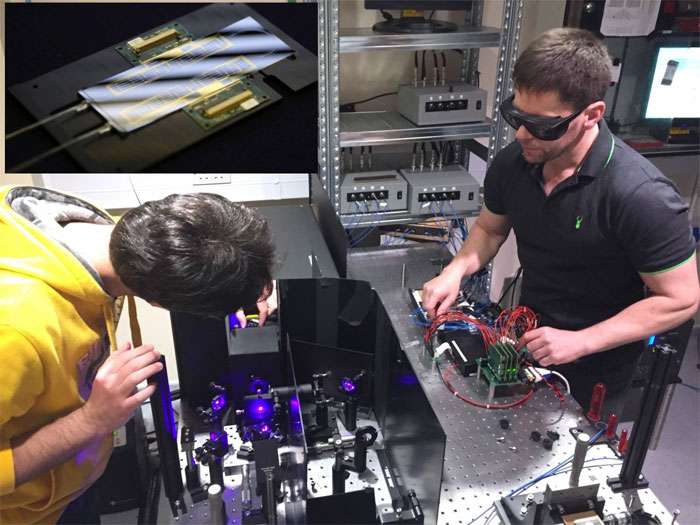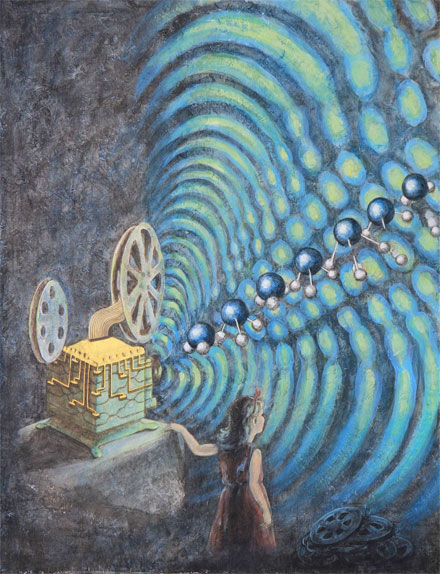
Photonic Chip Used as Quantum Simulator to Model Molecular Dynamics
BRISTOL, England, May 31, 2018 — An international scientific team has shown how an optical chip can simulate the motion of atoms within molecules at the quantum level. Data from the chip allows a frame-by-frame reconstruction of atomic motions to create a virtual movie of a molecule’s quantum vibrations.
Researchers exploited the natural mapping between vibrations in molecules and photons in waveguides. They simulated the time evolution of vibrational excitations in the harmonic approximation for several four-atom molecules. They then simulated coherent and dephased energy transport in the simplest model containing the peptide bond in proteins — N-methylacetamide — and simulated thermal relaxation and the effect of anharmonicities in H2O.

In Anthony Laing's lab, single photons of light are generated using a powerful Ti:sapphire laser to pump a series of nonlinear crystals, operated by Ph.D. student Nicola Maraviglia (left). The single photons are collected into optical fibers and injected into the photonic chip, next to Laing, physicist and project leader (right). Inset top left is a closeup of the photonic chip taken by scientist Nobuyuki Matsuda of NTT Electronics Corp. Courtesy of University of Bristol.
“We can program a photonic chip to mimic the vibrations of a molecule, mapping its components to the structure of a particular molecule, say ammonia, and then simulate how a particular vibrational pattern evolves over some time interval. By taking many time intervals, we essentially build up a movie of the molecular dynamics,” said Anthony Laing, University of Bristol physicist and project leader.
Researchers used multiphoton statistics with a feedback control algorithm to iteratively identify quantum states that increased a particular dissociation pathway of ammonia (NH3).
“The chip can be reprogrammed in a few seconds to simulate different molecules,” said Bristol researcher Chris Sparrow.
“In these experiments we simulated the dynamics of ammonia and a type of formaldehyde, and other more exotic molecules. We simulated a water molecule reaching thermal equilibrium with its environment, and energy transport in a protein fragment," said Sparrow. “In this type of simulation, because time is a controllable parameter, we can immediately jump to the most interesting points of the movie. Or play the simulation in slow motion. We can even rewind the simulation to understand the origins of a particular vibrational pattern.”
“We were also able to show how a machine learning algorithm can identify the type of vibration that best breaks apart an ammonia molecule," said Enrique Martín-Lopéz, a researcher with Nokia Bell Labs. "A key feature of the photonic simulator that enables this is its tracking of energy moving through the molecule, from one localized vibration to another.”

An artist’s impression of the photonic quantum simulations. The photonic chip, composed of waveguides controlled through gold electronic wiring, is seen as a film projector. The light of the projector is quantum and the movie is the frame-by-frame evolution of an ammonia molecule vibrating. In this movie, the initial vibrational state of the ammonia molecule leads to a very high probability that it will lose one of its hydrogen atoms at the end of the movie. The girl is a scientist of the future who will use the simulator as a tool for molecular modeling. The pile of film reels on the floor beside her signifies the capability of the photonic chip to be reprogrammed to simulate any molecule. Courtesy of Eleonora Martorana/Rome Academy of Fine Arts.
These findings are the result of a collaboration among researchers at the University of Bristol, Massachusetts Institute of Technology, Indiana University-Purdue University Indianapolis (IUPUI), Nokia Bell Labs, and NTT Electronics Corp. The research could prompt new methods of molecular modeling, which in turn could play a role in the early application of photonic quantum technologies.
Controlling the behavior of molecules requires an understanding of how they vibrate at the quantum level. But modeling these dynamics requires massive amounts of computational power, beyond what currently exists or is expected to exist in future generations of supercomputers.
An optical chip uses light instead of electricity and can operate as a quantum computing circuit.
“With this platform, in addition to vibrations of a stand-alone molecule, we are able to model the effects of environment on these quantum vibrations,” said Yogesh Joglekar, IUPUI physicist.
“The chip allows us to study open quantum systems, an extremely challenging subject.”
The photonic chip used in the experiments was fabricated by NTT.
Further development of the quantum simulation techniques used by researchers has clear industrial relevance, said Martín-Lopéz. It could pave the way for more efficient pharmaceutical developments and prompt new methods of molecular modeling for industrial chemists.
“Scaling up the simulators to a size where they can provide an advantage over conventional computing methods will likely require error correction or error mitigation techniques," said Laing. "And we want to further develop the sophistication of the molecular model that we use as the program for the simulator. Part of this study was to demonstrate techniques that go beyond the standard harmonic approximation of molecular dynamics. We need to push these methods to increase the real-world accuracy of our models."
“This approach to quantum simulation uses analogies between photonics and molecular vibrations as a starting point," Laing added. "This gives us a head-start in being able to implement interesting simulations. Building on this, we hope that we can realize quantum simulation and modeling tools that provide a practical advantage in the coming years.”
The research was published in Nature (doi:10.1038/s41586-018-0152-9).
/Buyers_Guide/NTT_Electronics_Corp/c10533